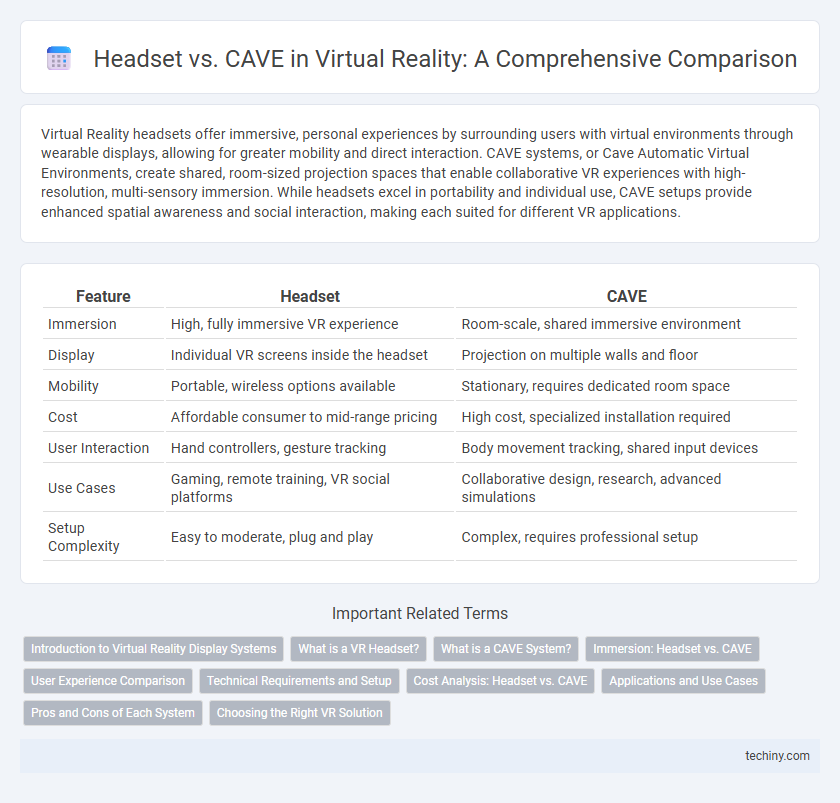Virtual Reality headsets offer immersive, personal experiences by surrounding users with virtual environments through wearable displays, allowing for greater mobility and direct interaction. CAVE systems, or Cave Automatic Virtual Environments, create shared, room-sized projection spaces that enable collaborative VR experiences with high-resolution, multi-sensory immersion. While headsets excel in portability and individual use, CAVE setups provide enhanced spatial awareness and social interaction, making each suited for different VR applications.
Table of Comparison
| Feature | Headset | CAVE |
|---|---|---|
| Immersion | High, fully immersive VR experience | Room-scale, shared immersive environment |
| Display | Individual VR screens inside the headset | Projection on multiple walls and floor |
| Mobility | Portable, wireless options available | Stationary, requires dedicated room space |
| Cost | Affordable consumer to mid-range pricing | High cost, specialized installation required |
| User Interaction | Hand controllers, gesture tracking | Body movement tracking, shared input devices |
| Use Cases | Gaming, remote training, VR social platforms | Collaborative design, research, advanced simulations |
| Setup Complexity | Easy to moderate, plug and play | Complex, requires professional setup |
Introduction to Virtual Reality Display Systems
Virtual Reality display systems primarily include headsets and CAVE (Cave Automatic Virtual Environment) setups, each offering distinct immersive experiences. Headsets like the Oculus Quest or HTC Vive deliver personalized, high-resolution visuals and precise motion tracking, enabling individual user engagement. In contrast, CAVE systems utilize multiple large projection screens to create shared, room-scale virtual environments ideal for collaborative simulations and research applications.
What is a VR Headset?
A VR headset is a wearable device that immerses users in a fully interactive virtual environment by displaying stereoscopic images directly in front of the eyes and tracking head movements in real-time. Equipped with sensors such as gyroscopes, accelerometers, and sometimes external cameras, VR headsets enable precise motion tracking and spatial audio for an enhanced immersive experience. Unlike CAVE systems that project images onto room-sized screens, VR headsets provide a portable and personalized virtual reality experience with high graphical fidelity and low latency.
What is a CAVE System?
A CAVE system, or Cave Automatic Virtual Environment, is an immersive virtual reality setup consisting of multiple large projection screens arranged in a cube or room-like configuration to create a shared, spatial VR experience. Unlike headsets, CAVE systems allow multiple users to simultaneously experience and interact within a virtual environment without wearing individual devices, offering enhanced collaboration and spatial awareness. These systems leverage advanced tracking and stereoscopic projection technologies to deliver high-resolution, room-scale virtual reality suited for scientific visualization, design, and training applications.
Immersion: Headset vs. CAVE
Virtual Reality headsets offer high immersion through wide field-of-view displays, motion tracking, and real-time audiovisual feedback that fully envelop users in virtual environments. In contrast, CAVE systems provide shared immersion by projecting images onto multiple walls and floors, allowing natural movement and collaboration but often with less sensory isolation. Headsets deliver personalized, intense immersion suitable for gaming and training, while CAVEs excel in group interaction and spatial awareness within virtual spaces.
User Experience Comparison
Virtual Reality headsets offer immersive, personal experiences with high-resolution displays and head-tracking technology, enabling users to explore virtual environments freely. In contrast, CAVE systems provide multi-user interaction within a shared physical space, utilizing projection screens to create a collaborative and spatially coherent experience. User experience in headsets excels in mobility and privacy, while CAVE environments enhance social immersion and natural body movement within a controlled setting.
Technical Requirements and Setup
Headsets require high-resolution OLED or LCD displays, precise motion tracking sensors, and powerful GPUs to render immersive environments with low latency. In contrast, CAVE systems demand multiple synchronized projectors, rear-projection screens, and advanced tracking technologies to create a room-scale VR experience with seamless visual continuity. Headsets offer a more compact setup with standalone or tethered configurations, while CAVE installations involve extensive space, calibration, and infrastructure for multi-wall projections.
Cost Analysis: Headset vs. CAVE
Virtual Reality headsets typically offer a more cost-effective entry point, with consumer models ranging from $300 to $1,000, while CAVE systems require multi-projected environments costing upwards of $50,000 due to specialized hardware and room-scale installations. Maintenance and scalability further increase CAVE expenses, whereas headsets benefit from ongoing consumer advancements and lower upkeep costs. For enterprises prioritizing budget and flexibility, headsets deliver superior value compared to the high capital investment and infrastructure demands of CAVE setups.
Applications and Use Cases
Virtual reality headsets excel in immersive gaming, training simulations, and remote collaboration with individual user tracking and portability. CAVE systems, offering room-scale projection and multi-user interaction, are preferred for architectural visualization, scientific research, and complex data analysis requiring spatial awareness. Both technologies enable distinct applications tailored to user scale, immersion level, and collaborative needs in virtual environments.
Pros and Cons of Each System
Virtual Reality headsets offer immersive, portable experiences with high-resolution visuals and precise tracking but can cause discomfort during extended use and limit social interaction. CAVE systems provide a collaborative environment with room-scale projection that supports multiple users and natural movement but require significant space and expensive hardware. Both technologies suit different applications, with headsets excelling in accessibility and personal immersion, while CAVEs favor shared, large-scale visualization and teamwork scenarios.
Choosing the Right VR Solution
Selecting the right VR solution depends on the intended application, with headsets offering immersive, personal experiences suitable for gaming and training, while CAVE systems provide collaborative, room-scale environments ideal for design reviews and data visualization. Headsets like Oculus Quest 2 or HTC Vive deliver portability and affordability with high-quality motion tracking, whereas CAVE setups involve multiple projectors and screens, enabling shared VR interactions but at a higher cost and space requirement. Understanding factors such as user interaction, scalability, and budget constraints ensures optimal VR implementation for specific organizational needs.
Headset vs CAVE Infographic

 techiny.com
techiny.com